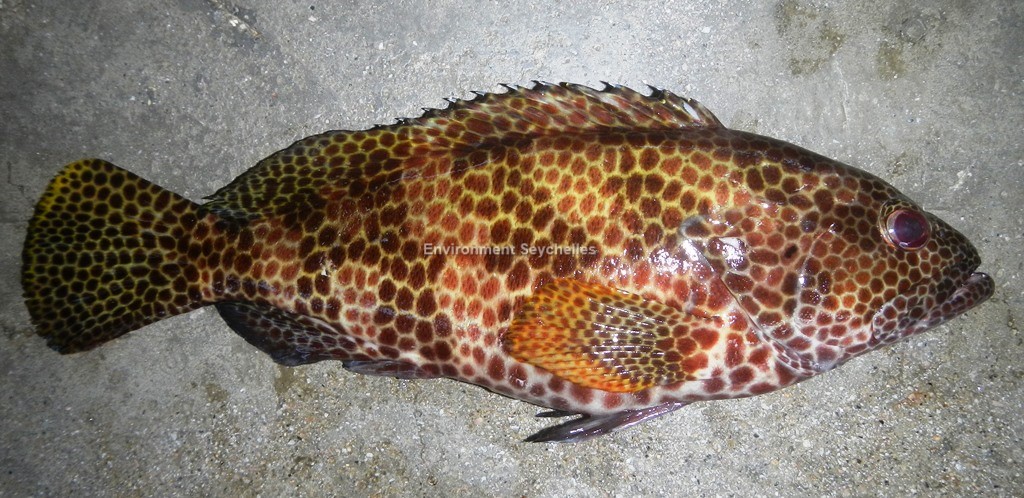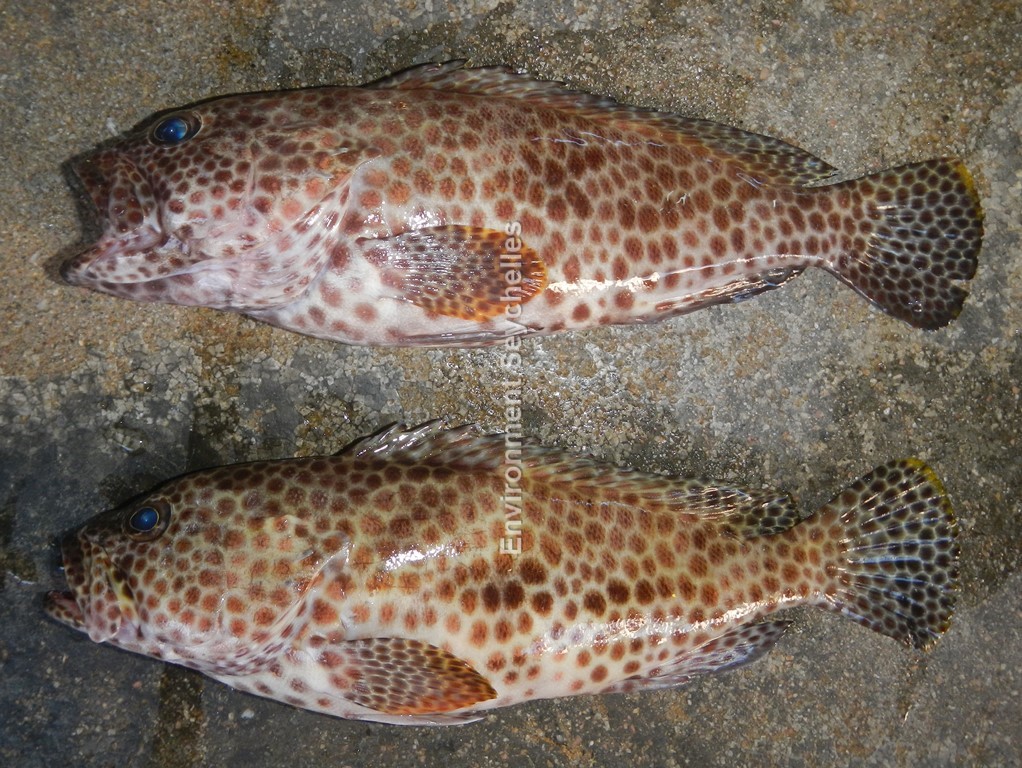Description:
Dorsal spines: 11; Dorsal rays: 15-17; Anal spines: 3; Anal rays: 8.
A small, moderately full-bodied, grouper. Dorsal head profile convex. Flat interorbital area. Posterior and anterior nostrils are subequal or posterior nostrils larger.
Maxilla reaches past vertical at rear edge of eye. Midlateral part of lower jaw with 2 to 4 rows of teeth, the inner teeth about twice the length of outer teeth. Rounded or
subangular preopercle, serrae at angle enlarged. Operculum with upper edge almost straight. Rounded caudal fin.
Colour. Head, body and fins pale, covered with close set dark brown or reddish brown polygonal spots the interspaces forming an irregular pale reticulum giving the species
its “honeycomb” common name. Spots on the ventral part of the body pale, more widely spaced and diffuse in outline. A series of about five darker diagonal bands, two to five
polygons wide, occur on the body, the anterior most radiating from the eye. Dark spots on median fins become smaller towards the fin margin. Tips of interspinous dorsal fin
membranes white or pale yellow with small sub-marginal dark patch. Pectoral fins covered with distinct brown spots.
Size:
Maturity: Lm unknown. Range 19- ? cm. Max Length: 32 cm TL.
Habitat and Ecology:
Inhabits coastal and offshore coral reefs (depth 0-50 m but typically less than 20 m). Favours shallow lagoons and semi-protected seaward reefs. Juveniles are common in
thickets of staghorn corals of the genus acropora. Feeds on fishes and small invertebrates. A protogynous hermaphrodite with changing from female to male at 3 to 5 years.
Solitary. Forms spawning aggregations outside home reef.
Fishery Status:
This species is not protected or subject to fishery regulations. It is caught occasionally in the fish trap fishery, but more commonly it is caught in nets that are illegally
dragged over the reefs/reef flats.
Notes:
It shares its creole name with E. spilotoceps. The name reflects that fishers state where this fish is found an octopus ("zourit") will be found nearby.
References:
Bray, D.J. Epinephelus merra in Fishes of Australia, http://fishesofaustralia.net.au/home/species/3848 (05/03/19).
Craig, M.T. et al. (2011). Groupers of the World - a field and market guide. NISC (Pty) Ltd, South Africa. ISBN: 978-1-920033-11-8
Froese, R. & D. Pauly. (Eds.) (2019). FishBase. https://www.fishbase.se/summary/4923 (05/03/19).
Law, C. et al. (2018). Epinephelus merra. The IUCN Red List 2018: http://dx.doi.org/10.2305/IUCN.UK.2018-2.RLTS.T132788A100551598.en. (05/03/19)
Citation:
Nevill, J.E.G. (2019). Epinephelus merra, Honeycomb grouper. Seychelles Seatizens. www.seatizens.sc. https://seatizens.sc/species/epinephelus-merra-bloch-1793/ (revised 20/07/22).




wow, awesome post.Really looking forward to read more. Fantastic.
I really liked your post.Thanks Again. Really Cool.
Thank you for your post.Much thanks again. Will read on…
Hey, thanks for the post.Really looking forward to read more. Great.
Major thanks for the blog.Thanks Again. Want more.
I really liked your blog.Thanks Again. Fantastic.
Thank you ever so for you article post. Awesome.
Thanks a lot for the blog article.Really looking forward to read more. Cool.
Thank you for your article.Thanks Again. Want more.
Thank you ever so for you article post. Will read on…
Great, thanks for sharing this blog post.Thanks Again. Keep writing.
Major thanks for the blog article. Want more.
Thank you ever so for you post.Really thank you! Much obliged.
I loved your article post. Fantastic.
Wow, great post. Keep writing.
Really enjoyed this article post.Thanks Again. Really Great.
Enjoyed every bit of your post.Thanks Again. Awesome.
Really enjoyed this blog.Thanks Again. Really Great.
wow, awesome article post.Really thank you! Fantastic.